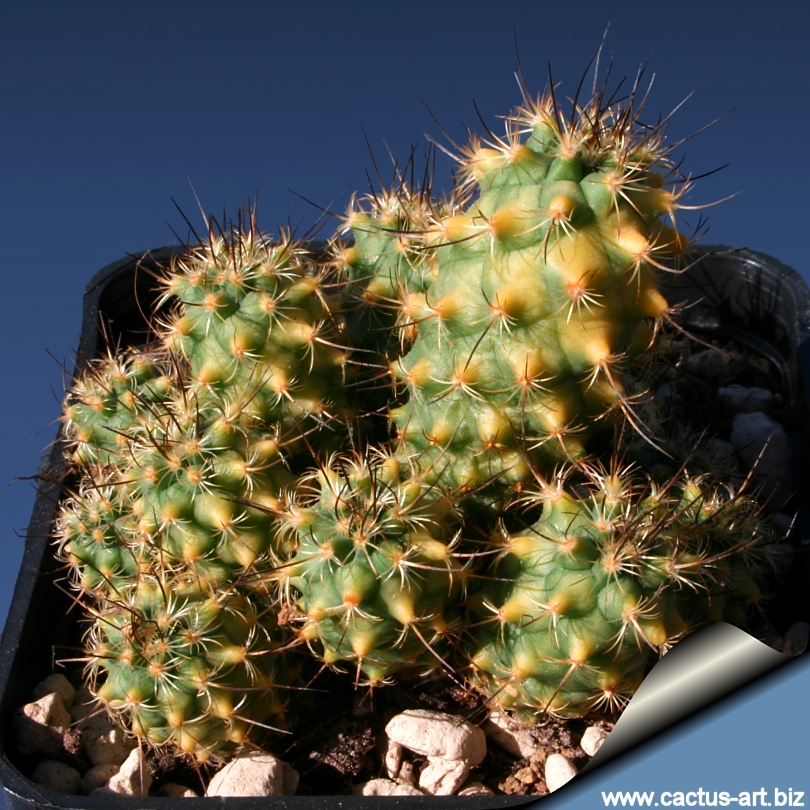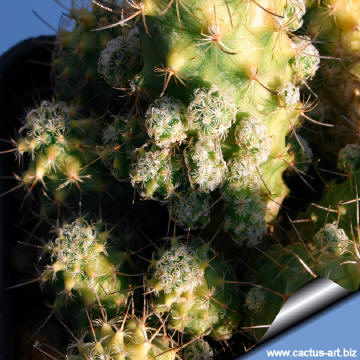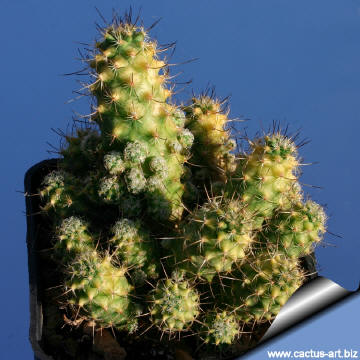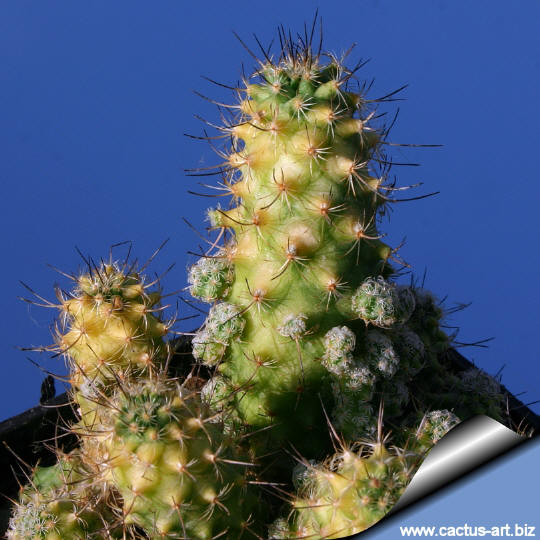|
|
|

Turbinicarpus roseiflorus forma variegata
Turbinicarpus roseiflorus is one of the prettiest Turbinicarpus
with lovely pink flowers.
|
Description: Turbinicarpus
roseiflorus is a small solitary or copiously branching cactus with
variable spination and also variable amounts of wool in the areoles.
Stem: Dark green, subspherical up to 3 cm tall, 4 cm in diameter.
Crown white-woolly;
Tubercles: Rhombic, prominent tubercles, forming
anti-clockwise diagonal spirals.
Areoles: Round, with white wool, later becoming naked.
Roots: Fibrous, copiously branching.
Radial spines: 6 to 13, of which the 6-8 lower ones much shorter,
white, radiating sideways porrect, dagger-like, 3-5 mm long, while the
3-4 upper ones porrect and curving towards the apex, 10-15 mm long,
black.
Central spines: 1 (to 2), porrect, slightly curved towards the
apex, the lower part, mostly twice as long as the longest radial spine,
black 1,5 mm wide flattened, black.
Flowers: Funnel-shaped, 2.5 cm long, 20 mm wide, petals pink ,
with dark mid-stripe on the reverse. Filaments greenish, anthers yellow.
Style white with 4 short white club-shaped lobes. The white flowered
form is also very attractive. Turbinicarpus roseiflorus "albiflorus"
Fruit: Oblong, to 5 mm long, at maturity brownish and dehiscing
vertically.
|
 |
 |
|
Advertising
|
|
|
|
|
Family:
Cactaceae (Cactus
Family)
Scientific Name:
Turbinicarpus roseiflorus (Backeberg)
Frank
Published in: Succulenta 72(1):42, 1993
Turbinicarpus roseiflorus Backeberg,
Descr. Cact. Nov. 111:15 (1963). (nomen invalidium
ICBN Art 37.1)
Origin:
Nursery
produced variegated cultivar.
T. roseiflorus
is belived to come from
Mexico (exact place of discovery unknown).
It is closely related to
T. lophophoroides, but its spines
are more numerous, Flower concolorous pink, opening less widely. However the exact identification
of this plant is dubious. The plants sold under this name are probably
of hybrid origin. Possibly between T. lophophoroides and
one of the dark spined species previously included in Gymnocactus
i.e. gielsdorfianus or viereckii.
Etymology: Roseiflorus derives from the Latin
words "rosea", meaning rose pink flowers.
Conservation status: Listed in
CITES Appendix I

|
|
|
|
Cultivation: It’s a fairly easy and robust species to cultivate, but
very slow growing. It needs a
very well-drained soil, and requires strong sun to part sun to
keep the plant compact and low and to develop a good spinal
growth. Waterings should be rather infrequent to keep the plant compact,
and avoid its becoming excessively elongated and unnatural in
appearance. Furthermore it has a tap root, and watering
it properly is often difficult, because it tends to crack open or rot if
over-watered. Careful watering away from the body of the
plant will allow the areoles to keep their wool. Keep dry in winter, or when night temperatures
remain below 10° C. It is hardy to -4°C for a short period. Assure a
good ventilation.
Reproduction: From seed, since the plant rarely produces
plantlets, or
grafted.


|
|